Cultural Horizons of India (Volume 3)
Synopsis
The third volume of the Cultural Horizons of India begins with a new perspective on the evolution of tantras, based on Pali, Sanskrit, Chinese, Tibetan, Indonesian, and Singhalese sources. The development of texts of this genre, iconographic efflorescence, multiple strands of ritual, sculptures and paintings over the centuries contribute to a new understanding of the origins and ramifications of the tantras. The mingling of Indian, Iranian and Hellenic ideas and their reflection in the transmission of Buddhist concepts and practices to China and thence to Japan open up new possibilities of interpretations. The light cults lead to Maitreya, Amitabha, Rocana of the Avatamsaka and Vairocana of the carya and yoga tantras. The deification of kings and colossi of the Avatamsaka in Afghanistan, China and Japan are a crucial stage in tantra development. The continuity of the tantras can be seen in Chinese Vaipulya texts from the second century onwards. The etymologies of Trapusa and Bhallika, the first lay disciples of the Buddha, from Chinese and other sources lead to the NW. The first stupa erected by the two merchants during the life of the Buddha himself sheds new light on the evolution of the stupa. After a detailed analysis of the term Oddiyana, a new interpretation is provided which will change the prevalent ideas about the origins of the tantras. A stone inscription of Kuluta from Mathura and the names of the two Kushan princes on their portrait statues read anew as Naz and Mastana point to the Iranian onomastics of the Kushans. Comparative study of the Chinese and Uigur invocation to Sarasvatl from the Suvarna-prabhasa-sutra shows the importance of Uigur fragments for the study of Buddhist texts. Comparison of the words of dharams brings out their latent meaning, intentionally given an esoteric reconditeness. The Gilgit fragment of the Pratimoksa-sutra supplies hitherto missing portions of the Vinaya of the Mula-sarvastivadins. The multiple strata that go into the formation of the legend of Krishna have been pointed out in the 9th chapter. The Silk Route culminating in Tun-huang has been termed the Sutra Route as it lived as long as Buddhism flourished on both its northern and southern routes, bringing together many races in companionship. The iconography of Avalokitesvara in Tun-huang paintings has been classified into 50 types. French researches on the interrelation of India, Serindia and China, Ayurveda in Asia, and the flesh and blood of time in Indo-European languages, Sarhkhya, Buddhism and modern physics add to the value of the volume. The Cyavana-Vidan-vat legend and some other passages of the Jaiminlya-brahmana are discussed. A Sanskrit text on alaiikara from Indonesian lontars is a specimen of the ancient pedagogical methods; in fact, it is a lively record of how Sanskrit was taught in Classical Indonesia through the direct method. The Lotus Sutra/Saddharma-pundarika plays a crucial role in contemporary Japan in new lay movements. The Soka Gakkai International and its President Daisaku Dceda have put this Sutra in the centre-stage. Prof. Lokesh Chandra presents a detailed study of the thought of President Ikeda. The very first article of Prof. Lokesh Chandra published in 1943 on the Mani stone is reproduced as it was written half a century ago. The list of works xylographed by the printeries of the Potala at Lhasa, Drepung, Derge and Pepung, Mdzod. dge sgar.gsar are unique sources for the history of printing. The Nama-sanglti has been commented upon by hundreds of Indian, Tibetan and Mongolian scholars from the standpoint of different tantric genres. The author discusses the meanings of its tide in several traditions and its affiliation to various tantras. The life and works of Hjam.dbyans.bzhad. pa I are given. He is celebrated for his manuals of study (yig.cha), highly esteemed among the Gelukpas. Sum.pa.mkhan.po's treatise on horses has been compared with three Sanskrit texts. A conspectus of the Mongolian Tanjur and its comparison with the Red Peking Edition and the chronology of Buddhism in Buryatia from 1660 to the present day relate to Mongolian Buddhism. The volume ends with the iconography of Ganesa in Tibet.
Read more
41.40
37.26
$
46.00 $
Free delivery Wolrdwidе in 10-18 days
Ships in 1-2 days from New Delhi
Membership for 1 Year $35.00
Get it now and save 10%
Get it now and save 10%
BECOME A MEMBER











Bibliographic information